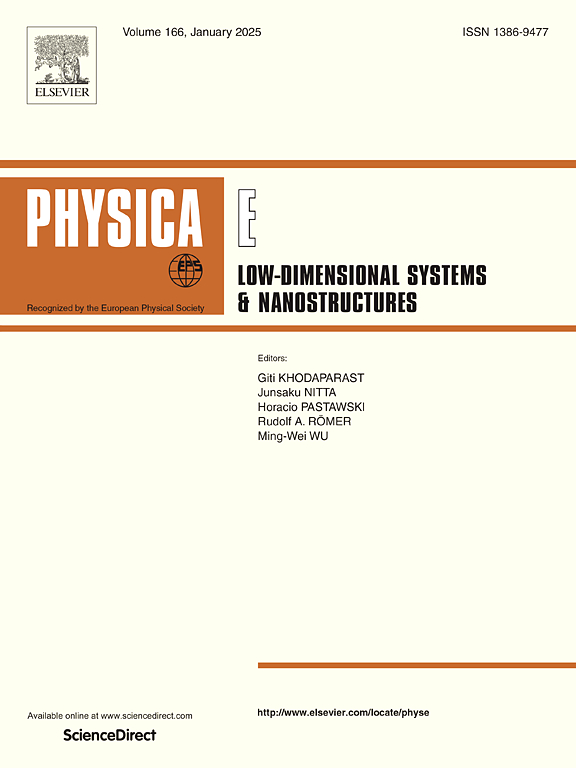Ultra-broadband tunable terahertz chiral metasurface integrated vanadium dioxides for tri-functional application
IF 2.9
3区 物理与天体物理
Q3 NANOSCIENCE & NANOTECHNOLOGY
Physica E-low-dimensional Systems & Nanostructures
Pub Date : 2025-04-11
DOI:10.1016/j.physe.2025.116270
引用次数: 0
Abstract
In this paper, an ultra-broadband tunable chiral metasurface (CMS) integrated vanadium dioxides (VO2) films is proposed for tri-functional application in terahertz (THz) region. The proposed composite CMS is composed of two twisted sub-wavelength metal gratings adhered on continuous VO2 films in front and back layers, metal deformed-split-ring resonator (DSRR) structure in a middle layer, which are separated by two dielectric layers. When VO2 is in insulating state, the designed composite CMS can achieve an ultra-broadband linear polarization conversion (LPC) and asymmetric transmission (AT) effect, exhibiting that the transmission coefficient of cross-polarization and AT coefficient exceed 90 % from 0.25 THz to 1.30 THz, with a relative bandwidth of 135 %. This ultra-broadband LPC and AT effect is primarily due to interlayer interference and cross-coupling effects of EM fields arising from the anisotropic and chiral characteristics of the CMS structure. However, when VO2 is in metallic state, the composite CMS can significantly reflect the incident THz waves, which promises to be used as a metal mirror reflector for electromagnetic (EM) shielding application. Furthermore, the ultra-broadband LPC efficiency and AT effect of the designed composite CMS can be dynamically modified by altering the conductivity of VO2, which is inherently temperature-dependent and passively modulates with environmental temperature shifts. Leveraging the phase transition property of VO2, the maximum modulation depth can reach an impressive 99.7 %. While the relative bandwidth for a modulation depth of 90 % extends up to 176 %. The proposed VO2 integrated CMS design serves as an important reference for practical applications of THz technology.
三功能应用的超宽带可调谐太赫兹手性超表面集成二氧化钒
本文提出了一种超宽带可调谐手性超表面(CMS)集成二氧化钒(VO2)薄膜,用于太赫兹(THz)区域的三功能应用。所提出的复合CMS由前后两层连续VO2薄膜上的两个扭曲亚波长金属光栅和中间两层由两层介电层隔开的金属变形裂环谐振器(DSRR)结构组成。当VO2处于绝缘状态时,所设计的复合CMS可实现超宽带线极化转换(LPC)和不对称传输(AT)效应,在0.25 ~ 1.30 THz范围内,交叉极化传输系数和AT系数均超过90%,相对带宽为135%。这种超宽带LPC和AT效应主要是由于CMS结构的各向异性和手性特性引起的电磁场的层间干扰和交叉耦合效应。然而,当VO2处于金属态时,复合CMS可以明显反射入射太赫兹波,有望作为电磁屏蔽应用的金属镜面反射器。此外,设计的复合CMS的超宽带LPC效率和AT效应可以通过改变VO2的电导率来动态改变,VO2的电导率固有地依赖于温度并被动地随环境温度变化而调节。利用VO2的相变特性,最大调制深度可以达到令人印象深刻的99.7%。而调制深度为90%时的相对带宽可扩展至176%。本文提出的VO2集成CMS设计为太赫兹技术的实际应用提供了重要参考。
本文章由计算机程序翻译,如有差异,请以英文原文为准。
求助全文
约1分钟内获得全文
求助全文
来源期刊
CiteScore
7.30
自引率
6.10%
发文量
356
审稿时长
65 days
期刊介绍:
Physica E: Low-dimensional systems and nanostructures contains papers and invited review articles on the fundamental and applied aspects of physics in low-dimensional electron systems, in semiconductor heterostructures, oxide interfaces, quantum wells and superlattices, quantum wires and dots, novel quantum states of matter such as topological insulators, and Weyl semimetals.
Both theoretical and experimental contributions are invited. Topics suitable for publication in this journal include spin related phenomena, optical and transport properties, many-body effects, integer and fractional quantum Hall effects, quantum spin Hall effect, single electron effects and devices, Majorana fermions, and other novel phenomena.
Keywords:
• topological insulators/superconductors, majorana fermions, Wyel semimetals;
• quantum and neuromorphic computing/quantum information physics and devices based on low dimensional systems;
• layered superconductivity, low dimensional systems with superconducting proximity effect;
• 2D materials such as transition metal dichalcogenides;
• oxide heterostructures including ZnO, SrTiO3 etc;
• carbon nanostructures (graphene, carbon nanotubes, diamond NV center, etc.)
• quantum wells and superlattices;
• quantum Hall effect, quantum spin Hall effect, quantum anomalous Hall effect;
• optical- and phonons-related phenomena;
• magnetic-semiconductor structures;
• charge/spin-, magnon-, skyrmion-, Cooper pair- and majorana fermion- transport and tunneling;
• ultra-fast nonlinear optical phenomena;
• novel devices and applications (such as high performance sensor, solar cell, etc);
• novel growth and fabrication techniques for nanostructures

 求助内容:
求助内容: 应助结果提醒方式:
应助结果提醒方式:


